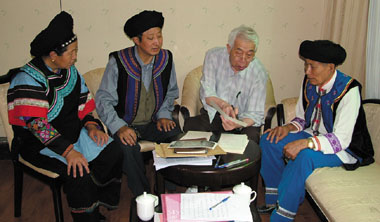|
|
.gif)
Historically important Asian languages, most
of which have come into contact with Chinese, have been captured
in a database, the first of its kind in East Asia. The research
has preserved vocabularies of more than 1,000 words from each of
99 Sino-Tibetan (ST) languages and dialects, mostly spoken in east
and southeast Asia and some of which are heading for extinction.
 |
| Prof Sun working on Ersu, a language with
about 20,000 speakers in Sichuan, China |
| Languages
in the database |
| (1) Tibeto-Burman: a large group
of languages including Yi (as in southwest China), Tibetan,
Tamang (Nepal), Burmese and Karen (Myanmar). |
| (2) Hmong-Mien: a small group of
languages spoken by the Hmong or Miao in Chinese and Mien
or Yao. |
| (3) Tai-Kadai: including Thai, Lao,
and some languages in China; such as Li (Hainan), Kam
or Dong (Guizhou), and Zhuang (Guangxi). |
| (4) Chinese |
| (5) Austroasiatic: including Wa
(China and Myanmar) and Mang (China and Vietnam). |
| (6) Austronesian:
including Atayal and Paiwan (Taiwan), and Tagalog or Filipino |
| (7) Reconstructions of the proto
or ancestral languages. |
|
The Queyu language, which currently only has about
7,000 speakers in Sichuan, China, is an example. Database material
also covers reconstructions of prehistoric Proto-Sino-Tibetan (PST)
words which evolved into today’s ST languages.
 Principal
Investigator, Professor and Dean (Emeritus) Pang-hsin Ting of the
Hong Kong University of Science and Technology (HKUST), said the database
will be of great help to linguists, and in preserving untapped history. Principal
Investigator, Professor and Dean (Emeritus) Pang-hsin Ting of the
Hong Kong University of Science and Technology (HKUST), said the database
will be of great help to linguists, and in preserving untapped history.
 An
objective of the research was to prove genetic relationships among
the languages. The most important finding of the research, said Prof
Ting, was proof that Tai languages, which include Thai, Lao and Zhuang
(spoken in Guangxi, China), are probably related to the Sino-Tibetan
family. An
objective of the research was to prove genetic relationships among
the languages. The most important finding of the research, said Prof
Ting, was proof that Tai languages, which include Thai, Lao and Zhuang
(spoken in Guangxi, China), are probably related to the Sino-Tibetan
family.
 “Previously,”
he said, “there was no definitive conclusion as to whether the
lexical similarities between Chinese and Tai were derived from cognates
or were the result of language contact. Now we think the two groups
are genetically related.” “Previously,”
he said, “there was no definitive conclusion as to whether the
lexical similarities between Chinese and Tai were derived from cognates
or were the result of language contact. Now we think the two groups
are genetically related.”
 Another
finding was that the Hmong-Mien language group, referred to in Chinese
as Miao and Yao, is probably related to the ST family, although more
study and evidence is needed, said Prof Ting. The database draws on
information collected over the last 40 years from more than 100 locations,
mostly carried out by researchers of the Chinese Academy of Social
Sciences, Beijing, including Prof Hongkai Sun, Co-I of the research
project. Another
finding was that the Hmong-Mien language group, referred to in Chinese
as Miao and Yao, is probably related to the ST family, although more
study and evidence is needed, said Prof Ting. The database draws on
information collected over the last 40 years from more than 100 locations,
mostly carried out by researchers of the Chinese Academy of Social
Sciences, Beijing, including Prof Hongkai Sun, Co-I of the research
project.
 Originally
constructed using the Chinese edition of FoxPro, the database can
now export query results to MS Word and Excel files. Plans include
making the database available on Internet this year. Originally
constructed using the Chinese edition of FoxPro, the database can
now export query results to MS Word and Excel files. Plans include
making the database available on Internet this year.
 Currently,
the database is at academic instutions in Beijing and Taipei as well
as HKUST. Users can search for words from the different languages
and dialects which are divided into seven categories (see panel).
They can also search for words using criteria such as meaning in Chinese
or English or strings of symbols from the international phonetic alphabet. Currently,
the database is at academic instutions in Beijing and Taipei as well
as HKUST. Users can search for words from the different languages
and dialects which are divided into seven categories (see panel).
They can also search for words using criteria such as meaning in Chinese
or English or strings of symbols from the international phonetic alphabet.
 Reconstruction
of the proto or ancestral languages, used more than 6,000 years ago,
is done by comparing the daughter languages and back-projecting the
most likely sounds used, Prof Ting added. Reconstruction
of the proto or ancestral languages, used more than 6,000 years ago,
is done by comparing the daughter languages and back-projecting the
most likely sounds used, Prof Ting added.
Principal
Investigator
Prof Pang-hsin Ting : shphting@ust.hk

|

